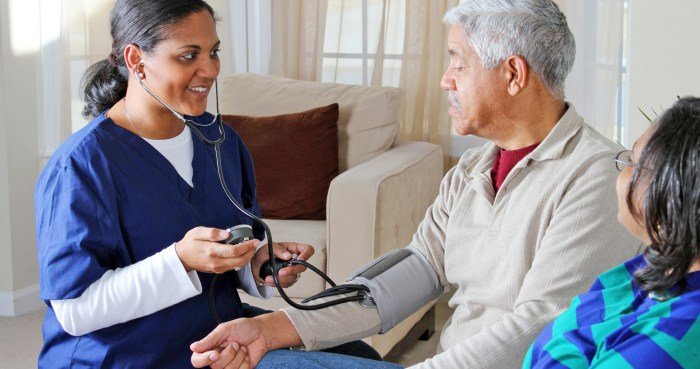At home health care – At-home health care takes center stage as a growing trend, offering a personalized and convenient approach to healthcare. This shift towards home-based care is driven by a multitude of factors, including the aging population, the increasing cost of traditional healthcare, and a growing desire for patient autonomy.
At-home healthcare services provide a wide range of medical and non-medical support, allowing individuals to receive care in the comfort and familiarity of their own homes.
From skilled nursing care to physical therapy and medication management, at-home healthcare services cater to diverse needs and health conditions. The benefits of receiving healthcare at home are numerous, including improved patient comfort, reduced risk of hospital-acquired infections, and enhanced patient independence.
However, challenges exist, such as ensuring patient safety and security, maintaining confidentiality, and managing patient and caregiver expectations. Technology plays a vital role in addressing these challenges, facilitating remote monitoring, communication, and data tracking, ultimately transforming the landscape of at-home healthcare.
The Growing Need for At-Home Healthcare

The demand for at-home healthcare services is on the rise, driven by a confluence of factors. These factors include an aging population, advancements in medical technology, and a growing preference for receiving care in the comfort of one’s own home.
Common Health Conditions Benefiting from At-Home Care
At-home healthcare offers numerous advantages for individuals managing various health conditions. It provides personalized care tailored to their specific needs, promoting independence and improving overall well-being.
- Chronic Diseases:Individuals with chronic conditions such as diabetes, heart disease, and arthritis can benefit significantly from at-home care. Regular monitoring, medication management, and support from healthcare professionals can help them manage their conditions effectively and prevent complications.
- Post-Hospital Care:Following hospitalization, patients often require continued care and rehabilitation. At-home healthcare services can provide essential support during this transition period, helping patients regain their strength and independence.
- End-of-Life Care:As individuals approach the end of their lives, they may prefer to receive care in a familiar and comfortable environment. At-home hospice care provides compassionate support, pain management, and emotional comfort to patients and their families.
Growth of the At-Home Healthcare Market, At home health care
The at-home healthcare market is experiencing substantial growth, fueled by the increasing demand for convenient and personalized care.
The global at-home healthcare market is projected to reach $265.3 billion by 2027, growing at a CAGR of 10.4%during the forecast period. (Source: Grand View Research)
This growth is attributed to several factors, including:
- Aging Population:As the global population ages, the demand for healthcare services, particularly those related to chronic conditions, is expected to increase significantly. At-home care provides a cost-effective and convenient solution for managing these conditions.
- Technological Advancements:Advancements in medical technology, such as telemedicine and wearable devices, have made it possible to provide high-quality healthcare services remotely. This has further fueled the growth of the at-home healthcare market.
- Shifting Patient Preferences:Many individuals prefer to receive care in the comfort of their own homes, where they can maintain their independence and enjoy familiar surroundings. This preference has led to a growing demand for at-home healthcare services.
Types of At-Home Healthcare Services: At Home Health Care

At-home healthcare services encompass a wide range of medical and non-medical assistance tailored to meet the unique needs of individuals in their own homes. These services provide personalized care, promoting independence, comfort, and improved quality of life.
Types of At-Home Healthcare Services
The spectrum of at-home healthcare services is vast, catering to diverse needs and preferences. Here is a table summarizing the different types:
| Service Type | Description | Benefits | Examples |
|---|---|---|---|
| Skilled Nursing Care | Provides medical care by registered nurses, including wound care, medication administration, and monitoring vital signs. | Reduces hospital readmissions, promotes faster recovery, and offers personalized care. | Post-surgical care, management of chronic conditions, and palliative care. |
| Personal Care | Offers assistance with daily living activities such as bathing, dressing, and toileting. | Enhances independence, maintains dignity, and allows individuals to remain in their homes. | Assistance with bathing, dressing, and mobility. |
| Homemaker Services | Provides help with household tasks such as cleaning, laundry, and meal preparation. | Reduces stress and burden on caregivers, promotes a safe and comfortable living environment, and allows individuals to maintain their independence. | Cleaning, laundry, grocery shopping, and meal preparation. |
| Companionship and Social Support | Offers companionship, social interaction, and emotional support to individuals who may feel isolated or lonely. | Combats loneliness, promotes mental well-being, and provides emotional support. | Conversation, outings, and activities. |
| Rehabilitation Services | Includes physical therapy, occupational therapy, and speech therapy to help individuals regain mobility, improve functionality, and manage conditions. | Promotes recovery, improves functional abilities, and reduces the risk of complications. | Physical therapy for stroke recovery, occupational therapy for hand injuries, and speech therapy for communication disorders. |
| Hospice Care | Provides specialized care for individuals with terminal illnesses, focusing on comfort, pain management, and emotional support. | Provides comfort and support during the end-of-life journey, promotes dignity and peace, and allows individuals to spend their final days in their preferred environment. | Pain management, emotional support, and spiritual guidance. |
Professionals Involved in At-Home Care
A diverse team of professionals contributes to the delivery of comprehensive at-home healthcare. These professionals work collaboratively to meet the unique needs of each individual:
- Nurses: Registered nurses (RNs) provide skilled nursing care, including medication administration, wound care, and monitoring vital signs. They also educate patients and families about their conditions and treatment plans.
- Aides: Certified nursing assistants (CNAs) and home health aides provide personal care, assistance with daily living activities, and companionship. They work under the supervision of nurses and follow individualized care plans.
- Therapists: Physical therapists (PTs), occupational therapists (OTs), and speech therapists (STs) provide rehabilitation services to help individuals regain mobility, improve functionality, and manage conditions. They develop personalized treatment plans and provide hands-on therapy.
- Doctors: Physicians provide medical oversight and guidance for at-home healthcare services. They may conduct home visits to assess patients’ conditions, adjust treatment plans, and ensure continuity of care.
Benefits of At-Home Healthcare

Receiving healthcare in the comfort of one’s own home offers a multitude of advantages, both for patients and their families. At-home healthcare allows individuals to maintain their independence and dignity while receiving the necessary medical care, contributing to their overall well-being and quality of life.
Improved Patient Comfort and Well-being
The familiar surroundings of home can significantly contribute to a patient’s sense of comfort and well-being. Being in a familiar environment reduces stress and anxiety, which can positively impact recovery and overall health. For individuals who are recovering from illness or surgery, being at home can promote a sense of normalcy and routine, facilitating a smoother transition back to daily life.
Reduced Risk of Hospital-Acquired Infections
Hospitals, while equipped to handle complex medical needs, are also environments where the risk of contracting infections is higher due to the concentration of patients with varying health conditions. At-home healthcare minimizes this risk, as patients are not exposed to the same level of potential pathogens found in hospital settings.
Enhanced Patient Autonomy and Independence
At-home healthcare empowers patients to maintain a greater sense of control over their health and well-being. Patients can participate actively in their care, making informed decisions about their treatment and lifestyle choices. This autonomy can contribute to a feeling of empowerment and independence, fostering a more positive and proactive approach to health management.
Potential Cost Savings Compared to Traditional Healthcare Settings
While the initial costs of setting up at-home healthcare services might seem higher, the overall cost savings can be significant compared to traditional hospital stays. The shorter length of stay, reduced risk of complications, and fewer associated costs like transportation and meals contribute to these savings.
Challenges of At-Home Healthcare

Providing quality healthcare in the comfort of a patient’s home comes with unique challenges that need careful consideration. These challenges can range from ensuring patient safety to managing expectations and coordinating care with other healthcare providers.
Ensuring Patient Safety and Security
Patient safety is paramount in any healthcare setting, and at-home healthcare is no exception. The home environment may not always be as controlled or equipped as a hospital or clinic, which can pose safety risks for patients.
- Home Hazards:Trips, falls, and other accidents can occur due to uneven floors, loose rugs, clutter, or inadequate lighting. Home healthcare providers need to be vigilant about identifying and mitigating these risks. For example, they might suggest removing tripping hazards, improving lighting, or installing grab bars in the bathroom.
- Medication Safety:Managing medication correctly is crucial for patient safety. Home healthcare providers must ensure that patients are taking the right medications, in the correct dosages, and at the right times. They also need to be aware of potential drug interactions and side effects.
At-home healthcare offers a personalized approach to managing health conditions, allowing individuals to receive care in the comfort of their own homes. While the idea of receiving medical attention might seem daunting, it’s important to remember that care can be tailored to individual needs, just like the transformations we see in stories like beauty & the beast , where inner beauty ultimately shines through.
With at-home healthcare, individuals can maintain their independence and dignity while receiving the support they need.
For example, they might use medication organizers, provide clear instructions, and check with the patient and their family about any concerns.
- Emergency Response:In case of an emergency, home healthcare providers need to be prepared to respond quickly and effectively. They should have access to emergency contact numbers and be familiar with the patient’s medical history. It is also important to have a plan for how to reach emergency services if needed.
For example, they might have a clear protocol for calling 911 or other emergency services, and they might carry a medical alert device or a mobile phone with a pre-programmed list of emergency contacts.
Maintaining Confidentiality and Privacy
Patient confidentiality is essential in healthcare, and it is particularly important in the home setting where sensitive medical information is shared in a personal space.
- Protecting Medical Records:Home healthcare providers need to ensure that patient records are kept secure and confidential. This includes protecting paper records from unauthorized access and using secure electronic systems to store and transmit patient information. For example, they might use password-protected electronic health records, encrypt sensitive data, and follow HIPAA guidelines for data privacy.
- Respecting Patient Boundaries:Home healthcare providers must respect patient privacy and avoid disclosing personal information to others. They should only share information with those who have a legitimate need to know, such as other healthcare providers involved in the patient’s care. For example, they might use a “need to know” approach when sharing patient information, and they might obtain patient consent before discussing their condition with family members or other caregivers.
- Maintaining Professionalism:Home healthcare providers need to maintain a professional demeanor at all times, even when working in a patient’s home. This includes dressing appropriately, avoiding personal conversations, and respecting the patient’s space. For example, they might dress in a clean uniform, avoid using their mobile phone during patient visits, and be mindful of their personal hygiene.
Managing Patient and Caregiver Expectations
Managing expectations is crucial for a successful home healthcare experience. Patients and their caregivers may have different expectations about the level of care, the frequency of visits, and the roles and responsibilities of the home healthcare provider.
At-home health care offers a personalized approach to managing health conditions, allowing individuals to receive care in the comfort of their own homes. While many appreciate the convenience and personalized attention of at-home care, it’s important to note that the lack of health insurance can come with a significant financial burden, as you may be subject to a penalty without health insurance.
Therefore, it’s crucial to consider the cost implications of both at-home care and health insurance before making a decision that aligns with your individual needs and financial resources.
- Clear Communication:Open and honest communication is essential for setting realistic expectations. Home healthcare providers should discuss the patient’s needs, the scope of services, and the limitations of home healthcare with the patient and their family. For example, they might use a care plan to Artikel the services provided, the frequency of visits, and the patient’s goals.
They might also schedule regular meetings to review the care plan and address any questions or concerns.
- Realistic Goals:Home healthcare providers should help patients and their caregivers set realistic goals for recovery and care. These goals should be achievable and measurable. For example, they might focus on improving mobility, managing pain, or maintaining independence. They might also work with the patient to develop a personalized exercise program or a nutrition plan.
- Addressing Concerns:Home healthcare providers should be responsive to patient and caregiver concerns. They should address these concerns promptly and professionally. For example, they might offer additional support services, adjust the care plan, or refer the patient to other healthcare providers if necessary.
Coordinating Care with Other Healthcare Providers
Home healthcare is often part of a larger healthcare plan that involves other providers, such as physicians, nurses, therapists, and pharmacists. Effective coordination of care is essential to ensure that the patient receives the right treatment at the right time.
- Communication and Collaboration:Home healthcare providers need to communicate regularly with other healthcare providers involved in the patient’s care. This includes sharing information about the patient’s condition, treatment plan, and progress. For example, they might use a secure electronic messaging system to communicate with other providers, attend regular team meetings, or provide written reports summarizing the patient’s care.
- Continuity of Care:Home healthcare providers should work to ensure continuity of care by coordinating with other providers to ensure that the patient’s needs are met throughout their treatment. For example, they might schedule appointments with specialists, arrange for medication refills, or provide transportation to appointments.
- Patient Advocacy:Home healthcare providers can advocate for the patient’s needs and ensure that they receive the appropriate level of care. For example, they might communicate with the patient’s physician to request adjustments to the treatment plan or to seek additional resources.
Technology in At-Home Healthcare

The healthcare industry is experiencing a rapid transformation driven by technological advancements. At-home healthcare is particularly benefiting from these innovations, leading to more efficient, accessible, and personalized care. Technology is empowering patients to take a more active role in their health management, while also enabling healthcare providers to deliver better care remotely.
Telehealth and Remote Monitoring
Telehealth refers to the use of technology to deliver healthcare services remotely. This includes video conferencing for virtual consultations, remote patient monitoring, and mobile health apps. Telehealth is revolutionizing at-home healthcare by bridging geographical barriers and providing access to specialized care for patients who might otherwise have difficulty accessing it.
- Virtual Consultations:Patients can connect with healthcare providers through video conferencing platforms, eliminating the need for in-person appointments. This is particularly beneficial for patients with mobility limitations or those living in remote areas.
- Remote Patient Monitoring:Wearable devices and sensors can collect vital health data, such as heart rate, blood pressure, and blood glucose levels, and transmit it to healthcare providers in real-time. This allows for early detection of health issues and timely intervention.
Mobile Applications for Patient Communication and Record-Keeping
Mobile applications are becoming increasingly popular in at-home healthcare. These apps facilitate communication between patients and healthcare providers, streamline record-keeping, and provide patients with valuable health information and resources.
- Patient Portals:Secure online platforms allow patients to access their medical records, schedule appointments, and communicate with their healthcare providers.
- Medication Reminders:Apps can remind patients to take their medications at the correct time and dosage, improving adherence to treatment plans.
- Health Information Resources:Many apps provide access to reliable health information, symptom checkers, and educational materials, empowering patients to take a more active role in managing their health.
Wearable Devices for Health Data Tracking
Wearable devices, such as smartwatches and fitness trackers, are increasingly used in at-home healthcare. These devices can track a wide range of health data, including heart rate, sleep patterns, activity levels, and even blood glucose levels. The data collected by these devices can provide valuable insights into a patient’s overall health and help identify potential health risks.
- Fitness Trackers:Track steps, distance, calories burned, and sleep patterns, providing valuable insights into a patient’s activity levels and sleep quality.
- Smartwatches:Measure heart rate, blood oxygen levels, and can even detect falls, providing real-time health monitoring and alerting caregivers in case of emergencies.
Future Trends in At-Home Healthcare

The landscape of at-home healthcare is undergoing a rapid transformation, driven by technological advancements, shifting demographics, and evolving patient preferences. This evolution is shaping the future of healthcare delivery, moving towards a more personalized, preventative, and accessible model.
At-home healthcare can encompass a wide range of services, from physical therapy to medication management. One popular way to improve fitness and overall health at home is through cycling. To get the most out of your indoor cycling sessions, it’s helpful to understand how many calories you’re burning, which you can calculate using resources like fitness bike calories burned.
This information can help you set realistic goals and track your progress, making your at-home fitness routine even more effective.
Increased Focus on Personalized and Preventative Care
The future of at-home healthcare is characterized by a strong emphasis on personalized and preventative care. This shift is driven by a growing understanding that proactive healthcare is more effective and cost-efficient in the long run. This approach involves tailoring treatment plans to individual needs and proactively addressing potential health issues before they escalate.
- Genetic Testing and Personalized Medicine:Advances in genetic testing allow healthcare providers to identify individual predispositions to specific diseases, enabling them to implement targeted preventative measures and personalized treatment plans. For instance, individuals with a genetic predisposition to heart disease can receive tailored advice on lifestyle modifications, medication, and early screening to mitigate their risk.
- Remote Patient Monitoring:Wearable devices and remote monitoring technologies empower patients to actively manage their health at home. Data collected from these devices provides valuable insights into a patient’s health status, allowing healthcare providers to intervene early and prevent complications. For example, a patient with diabetes can use a continuous glucose monitor to track their blood sugar levels and receive alerts if their levels are outside the target range, enabling timely adjustments to their medication or diet.
- Virtual Consultations and Telehealth:Telehealth platforms are becoming increasingly sophisticated, facilitating virtual consultations, remote monitoring, and medication management. This allows patients to access healthcare services from the comfort of their homes, reducing the need for frequent hospital visits and improving convenience. For instance, a patient with a chronic condition can receive regular virtual check-ups with their doctor, discuss medication adjustments, and receive personalized advice without leaving their home.
Growing Integration of Artificial Intelligence and Machine Learning
Artificial intelligence (AI) and machine learning (ML) are revolutionizing healthcare, and at-home healthcare is no exception. These technologies are enabling more efficient and personalized care delivery by analyzing vast amounts of data to identify patterns, predict health outcomes, and personalize treatment plans.
- AI-Powered Diagnostics:AI algorithms can analyze patient data, including medical history, symptoms, and test results, to assist in diagnosing diseases and identifying potential health risks. This can improve diagnostic accuracy and enable early intervention, leading to better outcomes. For example, AI-powered tools are being used to analyze medical images, such as X-rays and mammograms, to detect abnormalities that may be missed by human eyes.
- Predictive Analytics:AI and ML can analyze patient data to predict potential health risks and develop personalized intervention plans. This proactive approach can help prevent complications and improve patient outcomes. For instance, AI algorithms can analyze a patient’s medical history, lifestyle factors, and genetic information to predict their risk of developing certain diseases, allowing healthcare providers to intervene early with preventative measures.
- Chatbots and Virtual Assistants:AI-powered chatbots and virtual assistants can provide patients with 24/7 support and answer their health-related questions. These tools can also schedule appointments, remind patients about medication, and track their progress. For example, a patient recovering from surgery can use a virtual assistant to receive personalized reminders about their medication schedule, physiotherapy exercises, and follow-up appointments.
Expanding Access to At-Home Healthcare for Underserved Populations
At-home healthcare is becoming increasingly accessible to underserved populations, including those in rural areas, low-income communities, and individuals with limited mobility. This expansion is driven by a combination of factors, including technological advancements, government initiatives, and a growing recognition of the importance of equitable healthcare access.
- Telehealth and Remote Monitoring:Telehealth platforms and remote monitoring technologies are bridging the geographical gap in healthcare access, allowing individuals in rural areas to connect with healthcare providers and receive care from the comfort of their homes. This is particularly beneficial for patients who face long travel distances or lack access to specialized medical services in their communities.
- Community Health Centers and Mobile Clinics:Community health centers and mobile clinics are expanding their reach to provide essential healthcare services to underserved populations, including at-home care. These initiatives offer accessible and affordable healthcare options, particularly for individuals who lack health insurance or face financial barriers to accessing traditional healthcare facilities.
- Government Initiatives and Funding:Governments are increasingly investing in programs and initiatives that promote at-home healthcare access for underserved populations. These initiatives aim to address health disparities and ensure equitable access to quality healthcare for all citizens. For example, the Affordable Care Act in the United States has expanded access to healthcare services, including at-home care, for millions of Americans.
Ultimate Conclusion

As technology continues to evolve and the demand for personalized care grows, at-home healthcare is poised to become an even more integral part of the healthcare system. The future of at-home healthcare holds exciting possibilities, including the integration of artificial intelligence and machine learning, expanding access to underserved populations, and a greater focus on preventative care.
With its ability to provide high-quality care in a familiar and comfortable setting, at-home healthcare is poised to play a crucial role in improving the health and well-being of individuals across the globe.
FAQ Guide
What are the costs associated with at-home healthcare?
The cost of at-home healthcare varies depending on the type of services needed, the frequency of care, and the geographic location. It’s best to contact a home health agency for a personalized quote.
How do I find a reputable at-home healthcare agency?
You can ask for recommendations from your doctor, friends, or family. You can also search online for agencies in your area and read reviews from past clients. Make sure to verify the agency’s licensing and insurance credentials.
What are the qualifications of at-home healthcare providers?
At-home healthcare providers are licensed and certified professionals, including nurses, aides, therapists, and doctors. They undergo rigorous training and adhere to strict ethical and safety standards.